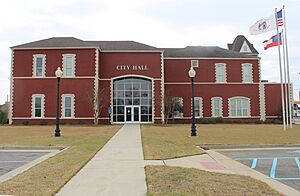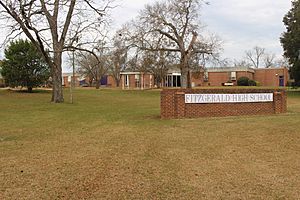Fitzgerald, Georgia facts for kids
Quick facts for kids
Fitzgerald, Georgia
|
|||
|---|---|---|---|
|
City
|
|||

Fitzgerald City Hall
|
|||
|
|||
| Motto(s):
"History, Harmony, Heritage"
|
|||

Location in Ben Hill County and the state of Georgia
|
|||
| Country | United States | ||
| State | Georgia | ||
| Counties | Ben Hill and Irwin | ||
| Area | |||
| • Total | 9.13 sq mi (23.64 km2) | ||
| • Land | 8.98 sq mi (23.25 km2) | ||
| • Water | 0.15 sq mi (0.39 km2) | ||
| Elevation | 361 ft (110 m) | ||
| Population
(2020)
|
|||
| • Total | 9,006 | ||
| • Density | 1,003.23/sq mi (387.34/km2) | ||
| Time zone | UTC−5 (EST) | ||
| • Summer (DST) | UTC−4 (EDT) | ||
| ZIP code |
31750
|
||
| Area code | 229 | ||
| FIPS code | 13-29528 | ||
| GNIS feature ID | 0355809 | ||
Fitzgerald is a city in and the county seat of Ben Hill County in the south central portion of the U.S. state of Georgia. As of 2020, its population was 9,006. It is the principal city of the Fitzgerald micropolitan statistical area, which includes all of Ben Hill and Irwin counties.
A small portion of Fitzgerald is in Irwin County.
Contents
History
Fitzgerald was developed in 1895 by Philander H. Fitzgerald, an Indianapolis newspaper editor and a former drummer boy in the Union Army, who founded it as a community for Civil War veterans – both from the Union and from the Confederacy. The majority of the first citizens (some 2700) were Union veterans. It was incorporated on December 2, 1896. The town is located less than 15 miles (24 km) from the site of the capture of Confederate president Jefferson Davis on May 10, 1865.
Fitzgerald is one of the few truly planned cities in the United States. The city was laid out as a square, with intersecting streets dividing it into four wards. Each of the wards was divided into four blocks and each block had sixteen squares. Streets running North/South on the east side of the city were named after Confederate ships and generals, whereas the ones on the west side were named after Union ships and generals.
After about a year, the citizens planned a Thanksgiving harvest parade. Separate Union and Confederate parades were planned. However, when the band struck up to play, the Confederates joined the Union veterans to march as one beneath the US flag.
In recent years, the unofficial, and sometimes controversial, mascot of the city has become the red junglefowl, a wild chicken native to the Indian subcontinent. In the late 1960s, a small number were released into the woods surrounding the city and have thrived to this day.
Geography
Fitzgerald is located in south central Georgia at 31°42′56″N 83°15′23″W / 31.71556°N 83.25639°W (31.715432, -83.256464). U.S. Route 129 passes through the center of the city, leading north to Abbeville, Hawkinsville, and eventually Macon, and south to Ocilla, Nashville, and Lakeland. U.S. Route 319 also passes through Fitzgerald, leading northeast to McRae and Dublin and southwest to Tifton.
According to the United States Census Bureau, the city has a total area of 9.0 square miles (23.3 km2), of which 8.8 square miles (22.9 km2) is land and 0.15 square miles (0.4 km2), or 1.64%, is water.
Demographics
| Historical population | |||
|---|---|---|---|
| Census | Pop. | %± | |
| 1900 | 1,817 | — | |
| 1910 | 5,795 | 218.9% | |
| 1920 | 6,870 | 18.6% | |
| 1930 | 6,412 | −6.7% | |
| 1940 | 7,388 | 15.2% | |
| 1950 | 8,130 | 10.0% | |
| 1960 | 8,781 | 8.0% | |
| 1970 | 8,187 | −6.8% | |
| 1980 | 10,187 | 24.4% | |
| 1990 | 8,612 | −15.5% | |
| 2000 | 8,758 | 1.7% | |
| 2010 | 9,053 | 3.4% | |
| 2020 | 9,006 | −0.5% | |
| U.S. Decennial Census | |||
| Race | Num. | Perc. |
|---|---|---|
| White (non-Hispanic) | 3,392 | 37.66% |
| Black or African American (non-Hispanic) | 4,804 | 53.34% |
| Native American | 38 | 0.42% |
| Asian | 74 | 0.82% |
| Other/Mixed | 295 | 3.28% |
| Hispanic or Latino | 403 | 4.47% |
At the 2020 United States census, there were 9,006 people, 3,346 households, and 1,932 families residing in the city.
By 2022 a part of the city was in Irwin County, but no people lived in that portion.
Arts and culture
The Dorminy-Massee House is now operated as a bed and breakfast. J. J. (Captain Jack) Dorminy built it in 1915 for his family; the two-story, colonial-style home is listed on the National Register of Historic Places.
The Blue and Gray Museum, located in the town's AB&A 1908 railroad depot, houses several artifacts that tell the story of the town's founding. The town also has a city government owned art gallery located in the Carnegie library on the edge of downtown.
Education
The Ben Hill County School District, which includes all of Ben Hill County, conducts pre-school to grade twelve, and consists of one pre-school, one primary school, an elementary school, a middle school, and a high school. The district has 217 full-time teachers and over 3,395 students.
- Ben Hill County PreK
- Ben Hill County Primary School
- Ben Hill County Elementary School
- Ben Hill County Even Start
- Ben Hill County Middle School
- Fitzgerald High School College and Career Academy
While the Irwin County portion is in the Irwin County School District, as of 2022 no people live in that portion.
Wiregrass Georgia Technical College – Ben Hill-Irwin Campus is located on the southern end of the county.
Media
- WRDO Real Radio 96.9
- Herald Leader Newspaper (Fitzgerald)
- WSWG, CBS TV
- CW44, CW TV
- WSWG2, My Network TV
- WOKA Dixie Country 106.7
- WOBB B-100
- WSIZ Radio MyFM 102.3 (Fitzgerald) @ 99.9 (Douglas)
Minor league baseball teams
Fitzgerald was home to a minor league baseball team in the Georgia State League from 1948, the league's first season of operation, through 1952. The team was called the Fitzgerald Pioneers. The club had no affiliation with any major league club during the five seasons of operation in the Georgia State League. After the 1952 season, the Fitzgerald Pioneers relocated to Sandersville and became the Sandersville Wacos, which were affiliated with the Milwaukee Braves for the 1953 season. The team ended their last season in 1956, under different affiliation.
Fitzgerald got a replacement team for the Pioneers in 1953 when the Moultrie Giants of the Georgia–Florida League moved to town. The Moultrie club was a charter member of the Georgia–Florida League when it began operations in 1946. After relocating to Fitzgerald and becoming an affiliate of the Cincinnati Redlegs, the new edition of the Fitzgerald Pioneers lasted one season (1954) saw the team name changed to the Fitzgerald Redlegs. After two years in Fitzgerald, the club returned to Moultrie. It ceased operating in 1958 under the name Brunswick Phillies.
After the Fitzgerald Redlegs left, the city was without a team for the 1955 season. The next year the Cordele club relocated to Fitzgerald after ten seasons in Cordele. They changed affiliation back to what were now called the Kansas City A's, and the Fitzgerald A's played for the 1956 season. In 1957, the club again changed its affiliation, to the Baltimore Orioles; the club was known as the Fitzgerald Orioles for the 1957 season. The Fitzgerald team relocated to Dublin, Georgia after the 1957 season and remained a Baltimore Orioles farm team; they played as the Dublin Orioles for the Georgia–Florida League's last year of operation. Fitzgerald has not had a minor league team in the 63 years since.
Notable people
- Morris B. Abram, president of Brandeis University and civil rights leader
- Brainard Cheney, author
- Neal Colzie, NFL defensive back
- General Raymond G. Davis, USMC, World War II hero, Korean War Medal of Honor recipient, Commander of the 3rd Marine Division in 1968–69 in Vietnam, and Assistant Commandant of the Marine Corps 1971–72
- Abner Jay, blues musician
- Frances Mayes, author
- Charlie Paulk, seventh pick of 1968 NBA draft
- Jason Poe, NFL offensive guard
- Joe Reliford, youngest professional baseball player
- Lecitus Smith, NFL guard
- Forrest Towns, 1936 Summer Olympics track star
- Jemea Thomas, former NFL cornerback
- Mary Verner, politician, Mayor of Spokane, Washington
See also
 In Spanish: Fitzgerald (Georgia) para niños
In Spanish: Fitzgerald (Georgia) para niños





